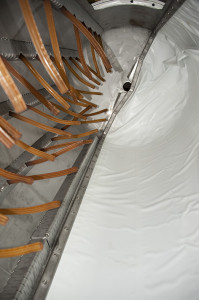Inside the press
July 8th, 2013 | Equipment
 Having just written about changing the membrane in one of our presses I thought that this might be the ideal moment to explain how the wine press really works…..
Having just written about changing the membrane in one of our presses I thought that this might be the ideal moment to explain how the wine press really works…..
Using today’s photo you can clearly see that the press is a cylinder more or less divided into two halves. On one side there is the new (beautifully white) inflatable membrane, whilst on the other side you can see a series of silicone rubber ‘fingers’. Once the press has been filled with grapes the pressing cycle begins and the whole cylinder rotates rather like a large tumble dryer. As it rotates the pneumatic membrane slowly inflates to a predetermined pressure, and the grapes are gently crushed, releasing their juice. The juice escapes through holes and is collected in a large tray underneath before it is chilled rapidly and moved to the tank room ready for fermentation. The membrane then deflates and the rubber ‘fingers’ begin to do their job.
Once the bag has deflated the cylinder rotates and the fingers serve to break up the compacted grape pomace. (Pomace is the mixture of grape skins and stalks – known as marc in French, and bagazo in Spanish). Once the pomace is broken up a little the membrane re-inflates to a slightly higher pressure and crushes the grapes again extracting yet more juice.
The length of the cycle, amount of pressure used and the number of pressings for each load of grapes is determined according to the requirement of the individual winemaker and the style and quality of wine they are attempting to make. Less pressing, less pressure and shorter cycles usually equate to a higher quality wine – indeed, some high quality wines are made entirely from ‘free run’ juice, or possibly just the first press. However, there is a danger that if the juice is too clean and pure, lacking in phenolic compounds, that the finished wine could potentially lack a bit of structure and balance.
Of course another decision which has to be made even before the grapes are pressed is whether they should be de-stemmed or not. Certainly the act of de-stemming will allow a much greater weight of grapes to enter the press (without the stems they occupy much less space), but on the downside, for a white wine maker, fruit oxidation starts from the very second that the skin of the fruit is broken. Again this is the winemaker’s choice, and again this will have an influence on the style of the finished wine.
 Having just written about changing the membrane in one of our presses I thought that this might be the ideal moment to explain how the wine press really works…..
Having just written about changing the membrane in one of our presses I thought that this might be the ideal moment to explain how the wine press really works…..
Using today’s photo you can clearly see that the press is a cylinder more or less divided into two halves. On one side there is the new (beautifully white) inflatable membrane, whilst on the other side you can see a series of silicone rubber ‘fingers’. Once the press has been filled with grapes the pressing cycle begins and the whole cylinder rotates rather like a large tumble dryer. As it rotates the pneumatic membrane slowly inflates to a predetermined pressure, and the grapes are gently crushed, releasing their juice. The juice escapes through holes and is collected in a large tray underneath before it is chilled rapidly and moved to the tank room ready for fermentation. The membrane then deflates and the rubber ‘fingers’ begin to do their job.
Once the bag has deflated the cylinder rotates and the fingers serve to break up the compacted grape pomace. (Pomace is the mixture of grape skins and stalks – known as marc in French, and bagazo in Spanish). Once the pomace is broken up a little the membrane re-inflates to a slightly higher pressure and crushes the grapes again extracting yet more juice.
The length of the cycle, amount of pressure used and the number of pressings for each load of grapes is determined according to the requirement of the individual winemaker and the style and quality of wine they are attempting to make. Less pressing, less pressure and shorter cycles usually equate to a higher quality wine – indeed, some high quality wines are made entirely from ‘free run’ juice, or possibly just the first press. However, there is a danger that if the juice is too clean and pure, lacking in phenolic compounds, that the finished wine could potentially lack a bit of structure and balance.
Of course another decision which has to be made even before the grapes are pressed is whether they should be de-stemmed or not. Certainly the act of de-stemming will allow a much greater weight of grapes to enter the press (without the stems they occupy much less space), but on the downside, for a white wine maker, fruit oxidation starts from the very second that the skin of the fruit is broken. Again this is the winemaker’s choice, and again this will have an influence on the style of the finished wine.


